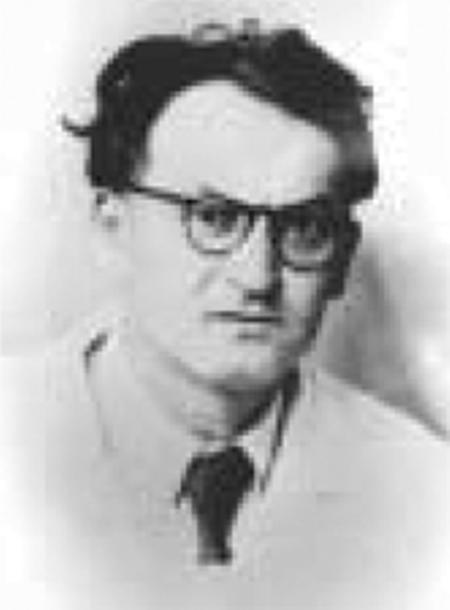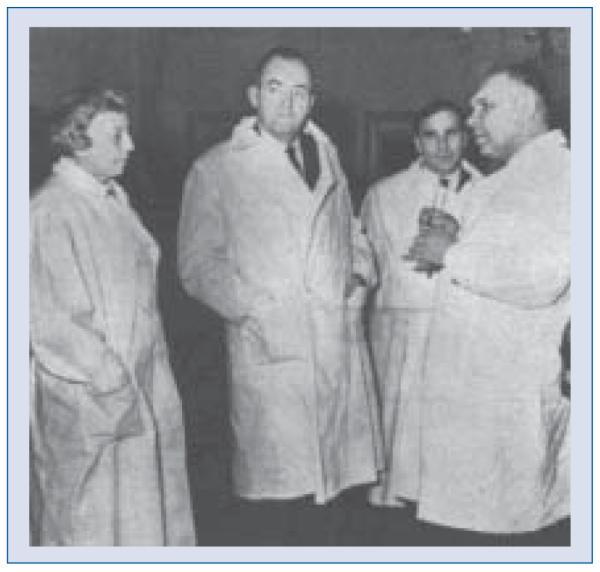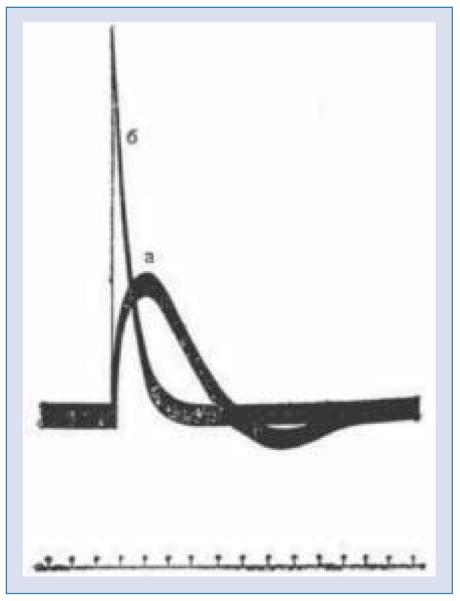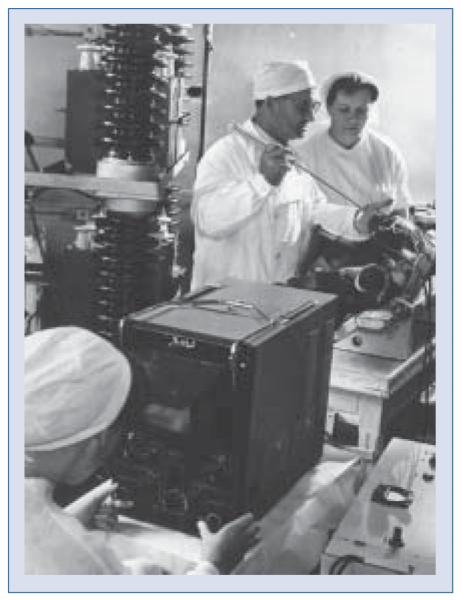History of defibrillation — international timeline

Defibrillation is one of the most important medical advances of the twentieth century. The history of cardiac defibrillation therapy is long and fascinating, spanning several centuries, many countries and continents. The treatment of sudden cardiac death with electricity was born in the minds of Danish, Italian, French and British physicians and physiologists, as evidenced by numerous eighteenth century publications in these languages. This culminated in arguably the first report, by Charles Kite [1], of the treatment of cardiopulmonary arrest by electricity. Nineteenth century cardiac physiology brought about the recognition of arrhythmia as a direct cause of death and provided compelling evidence for the ability of electric stimulation to restore normal sinus rhythm. This was first demonstrated in canines by Prevost and Battelli [2] in 1899. The twentieth century has finally brought to fruition three centuries of research and developed an array of therapies that now save millions of lives world-wide.
Our recent book “Cardiac Bioelectric Therapy: Mechanisms and Practical Implications” [3] presents a brief history of defibrillation, which was a result of the lifetime labor of many prominent physiologists from Denmark, Italy, England, Germany, France, Switzerland, Russia, Czechoslovakia, and the United States, among other countries. Many of the contributors to this history are well known, including the Danish veterinarian P.C. Abdilgaard, English physician Charles Kite, German physiologist Karl Ludwig, Swiss physiologists Jean-Louis Prevost and Frederic Battelli, and American physiologists and cardiologists Carl J. Wiggers, William Kouwenhoven, Cloude S. Beck, Paul Zoll, and Michel Mirowski. However, one of the most critically important contributors to the development of defibrillation therapy, Professor Naum L. Gurvich, is almost unknown in the West, because he worked behind the iron curtain with limited exposure to the international cardiology community, being unable to travel outside of Soviet borders and present his research results until later stages of his career.
Interestingly, it was an American politician who initiated bridging the gap between the West and East in the field of cardiology. In 1958, the United States Senator from Minnesota and future Vice President of the United States Hubert H. Humphrey visited Moscow. Contemplating his upcoming presidential bid, he focused on building his record in international affairs. He went to Moscow to meet with the Soviet communist party leader and premier minister, Nikita Khrushchev. During a single, eight hour marathon meeting, they discussed numerous issues, which Humphrey eloquently described in an article in Life magazine [4]. Along with issues of nuclear nonproliferation and West-East economic cooperation, Hubert H. Humphrey discussed his visit to the Moscow Institute of Reanimatology (Resuscitation), where he met with the Institute’s director, Vladimir A. Negovsky, MD, and the Institute’s leading defibrillation researcher, Naum L. Gurvich, MD.
Senator Humphrey represented well his State of Minnesota, which later became a world capital of biomedical implantable device industry. Senator Humphrey immediately recognized the importance of defibrillation and a number of leading American cardiologists followed in his footsteps and visited the Gurvich laboratory. In several years, Humphrey established a federal program within the United States National Institutes of Health, which supported the important fields of physiology and medicine [5]. In 1962 he called upon creating such a program on the floor of the US Senate [5] (Fig. 1): “I do, however, want to state that it is one of the most important of all phases of medical research. Why? Because it concerns the most universal interest of man; namely: the prolongation of human life, the postponement of death, and, yes, perhaps the greatest scientific frontier — the reversibility of death...
Figure 1.

Mrs. and Senator Hubert H. Humphrey during their visit to Institute of Reanimatology, Russian Academy of Medical Sciences, 1958. Director of the Institute, Professor Vladimir A. Negovsky (right) describes research program on resuscitation, which he directs.
What do I urge, therefore? I urge establishing under NIH support of specialized centers or institutes on the physiology of death, on resuscitation and on related topics. I urge that the United States compete with the USSR in bold research toward at least partial conquest of death. Already our scientists and Russian scientists are cooperating in categorical studies of heart ailments, cancer and other diseases. Now, let us recognize that a new category has emerged — the oldest category in the world — but one which commands our newest efforts — the category of death, itself...”.
Naum L. Gurvich and development of defibrillation in Soviet Union
Naum L. Gurvich was born on April 15, 1905 in a teacher’s family in the village of Timkovichi, near the capital of Byelorussia, Minsk. He started his medical education in 1923 in the State Crimean University (now Ukraine). A year later, due to the breakup of this university, he transferred to the Saratov Medical School in Russia. He graduated with an MD in 1928 and practiced as a family physician for 4 years in the village of Volovo, near Moscow. But his dream was medical research. In 1932, he was fortunate to be accepted into the graduate program at the Institute of Physiology in Moscow, which was, at the time, one of the most dynamic and productive experimental physiology and biochemistry institutes in Russia.
His mentor there was the director of the Institute of Physiology, Professor Lina S. Stern. Stern was a former trainee and associate of Prevost in Geneva, who discovered defibrillation with Battelli in 1899 [2]. As Prevost’s advisee, Lina Stern conducted research on defibrillation. Working in collaboration with Battelli, she also developed a novel methodology for respiratory research. But her major interests were in the field of the blood-brain barrier. Several Soviet emissaries visited her in Geneva, trying to recruit her as a highly successful scientist and educator at the University of Geneva. Finally, after several unsuccessful attempts to get promoted to a full professorship in Geneva, Lina Stern accepted an offer of Chair in Physiology and a position as head of laboratory of the 2nd Medical University in Moscow [6] in 1925.
Gurvich quickly became an enthusiastic member of the Stern research laboratory in Moscow. His PhD project was the study of electric stimulus induced arrhythmogenesis and defibrillation. In 1939, Naum Gurvich was awarded a PhD for his work “On excitation of intramural system by sinusoidal current of low frequency”. The same year he coauthored a paper with Dr. G.S. Yuniev, in which they proposed the use of capacitor discharge for defibrillation instead of an alternating current [7]. During his PhD research, Gurvich found that alternating current, although capable of defibrillation, causes damage to the myocardium, preventing spontaneous recovery of the sinus rhythm, in contrast to capacitor discharge defibrillation, which has higher safety and efficacy (Fig. 2).
Figure 2.
Early experiments on the biphasic waveform by Gurvich (1947). Graph shows the comparative amplitude and length of the electric discharge in defibrillation of the heart of a dog (a) using a capacitor-inductor circuit and (b) using a capacitor only [8].
In the 1940s, Gurvich and Yuniev proposed the use of a defibrillation waveform, that several decades later became known as the biphasic waveform for defibrillation [8]. In 1947, the race for successful clinical defibrillation was won by Dr. Claude Beck and his group of investigators [9] from the University Hospitals in Cleveland, USA. This group benefited from extensive work on the physiological mechanisms of defibrillation and shock-induced fibrillation carried out by Wiggers [10], chair of the Physiology Department of the Western Reserve University. Yet, they used AC defibrillation, despite introduction of DC waveforms by Gurvich and Yuniev [7, 8].
During the next several years, defibrillation research reached a stand-still in the Soviet Union due to tragic Stalinist purges, in which the paranoid dictator initiated post-World War II criminal and political trials of real and imagined opposition. Following victory in World War II, Stalin began to re-establish his brutal rule, which was somewhat relaxed during the war. Stalinist’s trials in the later 1940s had numerous victims, including Professor Lina S. Stern. During World War II, Stalin’s regime initiated the establishment of various non-governmental organizations, which worked on assisting allies’ war efforts. Being a prominent academic leader, well known in the West, Lina Stern was asked to join a newly established Anti-Fascist Jewish Association. This association provided tremendous help to causes of anti-fascist allies, raising millions of dollars from the American Jewish community. When the war was over, Stalin, in his paranoia, accused the most prominent members of this association of espionage. Fifteen members of the association were tried and sentenced to death. All but one perished. Lina Stern was the only survivor, but was imprisoned for 4 years and then exiled.
Following Lina Stern’s arrest, her Institute of Physiology was disbanded. Gurvich lost his research position with many other employees. Fortunately, in 1948, he was able to find a position in the Laboratory of Experimental Physiology of Resuscitation, Academy of Medical Sciences of USSR, Moscow. This laboratory was created and directed for over half a century by Professor Vladimir A. Negovsky, who later transformed it into the Institute of General Reanimatology, Academy of Medical Sciences of USSR.
The main focus of Gurvich’s research career was the mechanisms of initiation and maintenance of fibrillation and defibrillation. In the early 1940s, he introduced the hypothesis of defibrillation as the stimulation of the myocardium by shock. This was in contrast to the dominating theories of shock-induced reversible incapacitation of the myocardium. He also introduced the concept of spatial heterogeneity in the ability to respond to high-frequency rhythms and the concept of “mother-reentry”, as foundations in the development and sustenance of fibrillation [11]. He also spent many years investigating the optimization of defibrillation therapy. His findings and physiological theories were presented in two comprehensive Russian language monographs published in 1957 and 1975, respectively [11, 12].
In the early 1950s Gurvich designed the first commercially available transthoracic DC-defibrillator in the world [11]. In 1970, he introduced the first biphasic transthoracic defibrillator, which became standard in the Soviet medical practice since that time, preceding Western analogs by at least 2 decades [12] (Fig. 3).
Figure 3.
Professor Naum L. Gurvich and his assistants conduct canine defibrillation experiment in 1969, Moscow.
His work on the development and clinical implementation of defibrillation therapy was recognized by the prestigious in the USSR State Prize. Biphasic waveforms are now commonly accepted in defibrillation therapy, replacing monophasic waveforms, which still remain in use in some transthoracic defibrillators, despite clear evidence of their inferiority in comparison with biphasic waveforms. A biphasic waveform, known as the Gurvich waveform, has been used in Russian-made transthoracic defibrillators since the early 1970s.
Professor Gurvich was not only a brilliant electrophysiologist, but also an excellent mentor and colleague of many who remember him with deep gratitude and respect. In a biography of Naum Lazarevich Gurvich, his former supervisor Professor Vladimir A. Negovsky and his advisee Dr. Margarita S. Bogushevich reminisce: “He was a remarkable research advisor... a kind and generous man, who shared his vast knowledge with young scientists. His numerous pupils work in many cities of Russia”.
Naum Gurvich lived and worked during difficult times under one of the worst dictatorships in the history of humankind. Under these tragic circumstances, he showed an example of devotion to medicine and physiology worthy of admiration. Gurvich rightfully deserves his place in medical history on the basis of his discovery, development and clinical implementation of a safe and effective biphasic transthoracic defibrillator, as well as his advancement of the theory of fibrillation and other numerous contributions to cardiovascular physiology.
References
- 1.Kite C. In: An essay on the recovery of the apparently dead. Dilly C, editor. London: 1788. p. 166. [Google Scholar]
- 2.Prevost JK, Battelli F. La mort par les d’escharges ‘electriques. J Physiol. 1899;1:1085–1100. [Google Scholar]
- 3.Efimov IR, Kroll M, Tchou PJ, editors. Cardiac bioelectric therapy: Mechanisms and practical implications. Springer; New York: 2008. [Google Scholar]
- 4.Humphrey HH. Life. New York: 1959. My marathon talk with Russia’s boss: Senator humphrey reports in full on Khrushchev — his threats, jokes, criticism of China’s communes; pp. 80–91. [Google Scholar]
- 5.Humphrey HH. An important phase of world medical research: Let’s compete with U.S.S.R. in research on reversibility of death. Congressional Records. 1962 October 13;:A7837–A7839. Saturday. [Google Scholar]
- 6.Dreifuss JJ, Tikhonov N. The intersection of personal and academic history: Lina Stern (1878–1968). In: Kokowski M, editor. The Global and the Local: The History of Science and the Cultural Integration of Europe; Proceedings of the 2nd ICESHS, Cracow; Poland. September 6–9, 2006.pp. 526–527. [Google Scholar]
- 7.Gurvich NL, Yuniev GS. Restoration of normal function in fibrillating heart of warm-blooded animals by condenser discharge. Bull Experiment Biol Med. 1939;8(1):55–58. (in Russian) [Google Scholar]
- 8.Gurvich NL, Yuniev GS. Restoration of heart rhythm during fibrillation by a condenser discharge. Am Rev Soviet Med. 1947;4:252–256. [PubMed] [Google Scholar]
- 9.Beck CS, Pritchard WH, Feil HS. Ventricular fibrillation of long duration abolished by electric shock. JAMA. 1947;135:985. doi: 10.1001/jama.1947.62890150005007a. [DOI] [PubMed] [Google Scholar]
- 10.Wiggers CJ. The mechanism and nature of ventricular defibrillation. Am Heart J. 1940;20:399–412. [Google Scholar]
- 11.Gurvich NL. Medgiz. Moscow: 1957. Fibrillation and defibrillation of the heart. [Google Scholar]
- 12.Gurvich NL. Medicine. Moscow: 1975. Basic principles of cardiac defibrillation. [Google Scholar]




